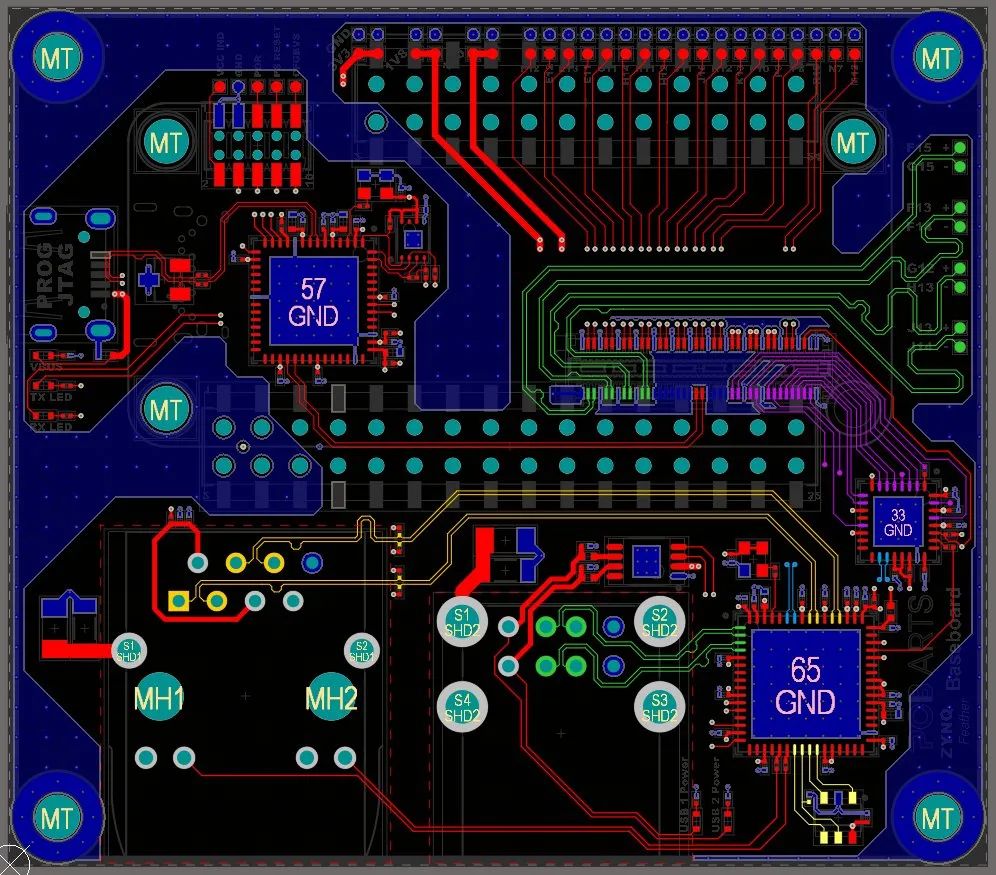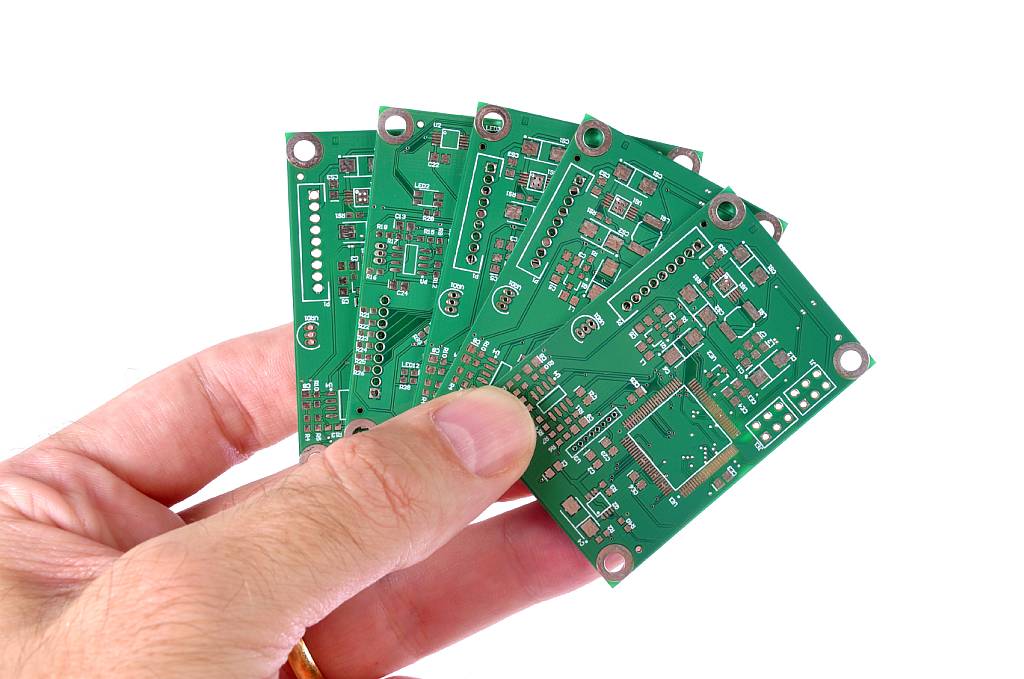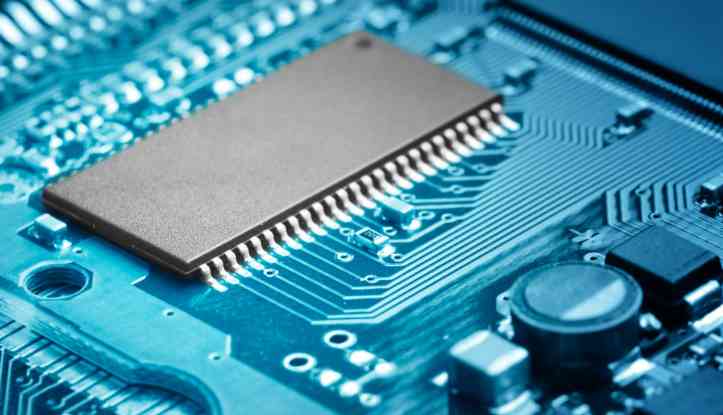
Demystify the whole process of PCB production
We have said before that: before the appearance of PCB, the circuit was first composed of point-to-point wiring. Later, winding technology was a major advancement in circuit technology. Later, the electronics industry developed from vacuum tubes and relays to Silicon semiconductors, as well as integrated circuits, electronic components are also falling in size and price. Electronic products appear more and more frequently in the consumer field, prompting manufacturers to look for smaller and more cost-effective solutions.
Thus, PCB was born.
The birth of PCB is not easy, and its production process is also very complicated. Taking a four-layer printed board as an example, its production process mainly includes PCB layout, core board production, inner layer PCB layout transfer, core board drilling and inspection, lamination , Drilling, copper chemical precipitation on the hole wall, outer layer PCB layout transfer, outer layer PCB etching and other steps.
1. PCB layout
GIF cover
The first step in PCB fabrication is to organize and check the PCB layout. The PCB production factory receives the CAD file. Since each CAD software has its own unique file format, the PCB factory will convert it into a unified format - Extended Gerber RS-274X or Gerber X2. Then the engineers in the factory will check whether the PCB layout conforms to the manufacturing process and whether there are any defects.
2. The production of the core board Clean the copper clad board, if there is dust, it may cause the final circuit to be short-circuited or disconnected.
GIF cover
The picture below is a legend of an 8-layer PCB, which is actually composed of 3 copper-clad laminates (core boards) plus 2 copper films, and then glued together with a prepreg. The production sequence is to start from the middle core board (4th, 5th layer circuit), stack them together continuously, and then fix them. The production of 4-layer PCB is similar, except that only 1 core board and 2 copper films are used.
3. Lamination
The inner layer PCB layout transfer needs to make the two-layer circuit of the most middle core board. After the copper clad board is cleaned, a layer of photosensitive film will be covered on the surface. This film will cure when exposed to light, forming a protective film on the copper foil of the copper clad laminate.
GIF cover
Insert the two-layer PCB layout film and the double-layer copper-clad board, and finally insert the upper PCB layout film to ensure that the upper and lower PCB layout films are stacked accurately.

GIF cover
The photosensitive machine uses UV light to irradiate the photosensitive film on the copper foil. Under the light-transmitting film, the photosensitive film is cured, and under the opaque film, there is still no cured photosensitive film. The copper foil covered under the cured photosensitive film is the required PCB layout circuit, which is equivalent to the role of the laser printer ink of the manual PCB.
Then wash off the uncured photosensitive film with lye, and the required copper foil circuit will be covered by the cured photosensitive film.
GIF cover
Then use a strong base, such as NaOH, to etch away the unwanted copper foil.
GIF cover
Tear off the cured photosensitive film to expose the required copper foil for PCB layout.
GIF cover
4. Core board punching and inspection
GIF cover
The core board has been fabricated successfully. Then punch alignment holes on the core board to facilitate alignment with other materials. Once the core board is pressed together with other layers of PCB, it cannot be modified, so inspection is very important. The machine will automatically compare with the PCB layout drawings to check for errors.
GIF cover
5. Lamination
A new raw material called prepreg is needed here, which is the adhesive between the core board and the core board, as well as the core board and the outer copper foil, and also plays the role of insulation.
The copper foil of the lower layer and the two layers of prepreg have been fixed in place through the alignment hole and the iron plate of the lower layer in advance, and then the prepared core board is also placed in the alignment hole, and finally the two layers of prepreg, a layer of copper foil and A layer of pressure-bearing aluminum plate covers the core.
GIF cover
The core board has been fabricated successfully. Then punch alignment holes on the core board to facilitate alignment with other materials. Once the core board is pressed together with other layers of PCB, it cannot be modified, so inspection is very important. The machine will automatically compare with the PCB layout drawings to check for errors.
GIF cover
The PCB boards clamped by the iron plate are placed on the bracket, and then sent into the vacuum heat press for lamination. The high temperature in the vacuum heat press can melt the epoxy resin in the prepreg, and fix the core boards and copper foils together under pressure.
GIF cover
After the lamination is completed, remove the upper iron plate that presses the PCB. Then the pressure-bearing aluminum plate is removed, and the aluminum plate also plays the role of isolating different PCBs and ensuring the smoothness of the copper foil on the outer layer of the PCB. At this time, both sides of the PCB taken out will be covered with a layer of smooth copper foil.
6. Drilling
To connect the 4 layers of non-contact copper foils in the PCB, firstly drill holes through the top and bottom to get through the PCB, and then metallize the walls of the holes to conduct electricity.
Use an X-ray drilling machine to position the core board of the inner layer. The machine will automatically find and locate the holes on the core board, and then make positioning holes for the PCB to ensure that the next drilling is from the center of the hole. Pass.
GIF cover
Put a layer of aluminum plate on the punch machine bed, then put the PCB on top. In order to improve efficiency, according to the number of PCB layers, 1~3 identical PCB boards will be stacked together for perforation. Finally, a layer of aluminum plate is covered on the top PCB. The upper and lower layers of aluminum plates are used to prevent the copper foil on the PCB from being torn when the drill drills in and out.
GIF cover
During the previous lamination process, the melted epoxy was squeezed out of the PCB, so it needed to be cut. The profile milling machine cuts the periphery of the PCB according to its correct XY coordinates.
GIF cover
7. Copper chemical precipitation on the hole wall
Since almost all PCB designs use through holes to connect different layers of lines, a good connection requires 25 microns of copper film on the hole wall. Copper film of this thickness needs to be achieved by electroplating, but the hole walls are composed of non-conductive epoxy resin and glass fiber board.
So the first step is to deposit a layer of conductive material on the hole wall, and form a 1-micron copper film on the entire PCB surface, including the hole wall, by chemical deposition. The entire process, such as chemical treatment and cleaning, is controlled by machines.
GIF cover
Fixed PCB
GIF cover
cleaning PCB
GIF cover
Shipping PCBs
8. Outer layer PCB layout transfer
Next, the outer layer PCB layout will be transferred to the copper foil. The process is similar to the principle of the previous inner core board PCB layout transfer. It uses photocopied film and photosensitive film to transfer the PCB layout to the copper foil. The only difference Yes, the positive film will be used as the board.
The inner layer PCB layout transfer adopts the subtractive method, and the negative film is used to make the board. The PCB covered by the cured photosensitive film is the circuit, and the uncured photosensitive film is washed away. After the exposed copper foil is etched, the PCB layout circuit is protected by the cured photosensitive film and remains.
The layout transfer of the outer layer PCB adopts the normal method, and the positive film is used as the board. The non-circuit area is covered by the cured photosensitive film on the PCB. Electroplating is performed after cleaning off the uncured photosensitive film. Where there is a film, it cannot be electroplated, but where there is no film, it is first plated with copper and then tin. Alkaline etching is performed after the film is removed, and finally the tin is removed. The circuit pattern remains on the board because it is protected by tin.
GIF cover
GIF cover
GIF cover
Clamp the PCB and plate the copper on it. As mentioned before, in order to ensure that the holes have sufficient electrical conductivity, the copper film electroplated on the hole walls must have a thickness of 25 microns, so the entire system will be automatically controlled by a computer to ensure its accuracy.
9. Outer layer PCB etching
Next, a complete automated assembly line completes the etching process. First, clean off the cured photosensitive film on the PCB. The unwanted copper foil covered by it is then cleaned with a strong base. Then use the tin stripping solution to remove the tin plating on the copper foil of the PCB layout. After cleaning, the 4-layer PCB layout is completed.
GIF cover
GIF cover
GIF cover
PCB is the most common device that hardware engineers deal with the most. Through a lot of accumulation and understanding of its characteristics, it can be used better for us and develop better innovative technology products.







